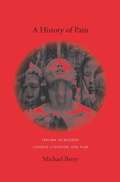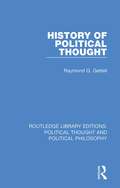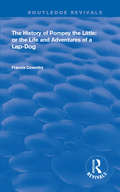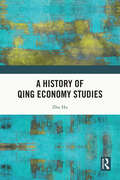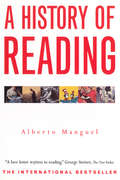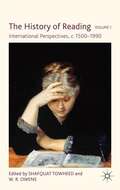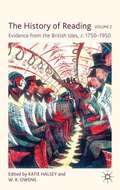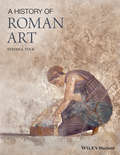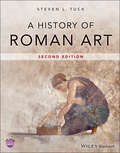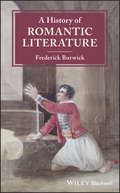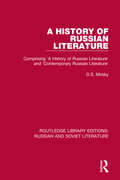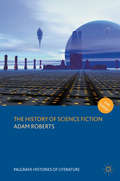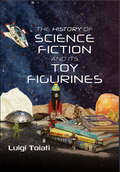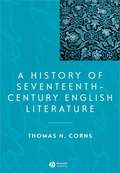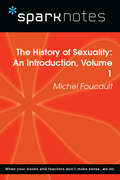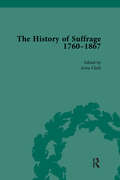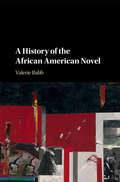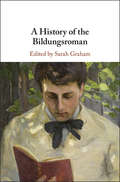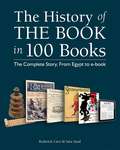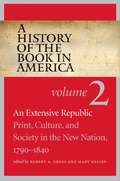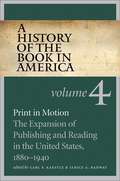- Table View
- List View
A History of Pain: Trauma in Modern Chinese Literature and Film (Global Chinese Culture)
by Michael BerryThe portrayal of historical atrocity in fiction, film, and popular culture can reveal much about the function of individual memory and the shifting status of national identity. In the context of Chinese culture, films such as Hou Hsiao-hsien's City of Sadness and Lou Ye's Summer Palace and novels such as Ye Zhaoyan's Nanjing 1937: A Love Story and Wang Xiaobo's The Golden Age collectively reimagine past horrors and give rise to new historical narratives.Michael Berry takes an innovative look at the representation of six specific historical traumas in modern Chinese history: the Musha Incident (1930); the Rape of Nanjing (1937-38); the February 28 Incident (1947); the Cultural Revolution (1966-76); Tiananmen Square (1989); and the Handover of Hong Kong (1997). He identifies two primary modes of restaging historical violence: centripetal trauma, or violence inflicted from the outside that inspires a reexamination of the Chinese nation, and centrifugal trauma, which, originating from within, inspires traumatic narratives that are projected out onto a transnational vision of global dreams and, sometimes, nightmares. These modes allow Berry to connect portrayals of mass violence to ideas of modernity and the nation. He also illuminates the relationship between historical atrocity on a national scale and the pain experienced by the individual; the function of film and literature as historical testimony; the intersection between politics and art, history and memory; and the particular advantages of modern media, which have found new means of narrating the burden of historical violence. As Chinese artists began to probe previously taboo aspects of their nation's history in the final decades of the twentieth century, they created texts that prefigured, echoed, or subverted social, political, and cultural trends. A History of Pain acknowledges the far-reaching influence of this art and addresses its profound role in shaping the public imagination and conception-as well as misconception-of modern Chinese history.
A History of Pain
by Michael BerryThe portrayal of historical atrocity in fiction, film, and popular culture can reveal much about the function of individual memory and the shifting status of national identity. In the context of Chinese culture, films such as Hou Hsiao-hsien's City of Sadness and Lou Ye's Summer Palace and novels such as Ye Zhaoyan's Nanjing 1937: A Love Story and Wang Xiaobo's The Golden Age collectively reimagine past horrors and give rise to new historical narratives.Michael Berry takes an innovative look at the representation of six specific historical traumas in modern Chinese history: the Musha Incident (1930); the Rape of Nanjing (1937-38); the February 28 Incident (1947); the Cultural Revolution (1966-76); Tiananmen Square (1989); and the Handover of Hong Kong (1997). He identifies two primary modes of restaging historical violence: centripetal trauma, or violence inflicted from the outside that inspires a reexamination of the Chinese nation, and centrifugal trauma, which, originating from within, inspires traumatic narratives that are projected out onto a transnational vision of global dreams and, sometimes, nightmares.These modes allow Berry to connect portrayals of mass violence to ideas of modernity and the nation. He also illuminates the relationship between historical atrocity on a national scale and the pain experienced by the individual; the function of film and literature as historical testimony; the intersection between politics and art, history and memory; and the particular advantages of modern media, which have found new means of narrating the burden of historical violence.As Chinese artists began to probe previously taboo aspects of their nation's history in the final decades of the twentieth century, they created texts that prefigured, echoed, or subverted social, political, and cultural trends. A History of Pain acknowledges the far-reaching influence of this art and addresses its profound role in shaping the public imagination and conception-as well as misconception-of modern Chinese history.
A History of Political Science (Elements in Historical Theory and Practice)
by Mark BevirThis Element denaturalises political science, stressing the contestability and contingency of ideas, traditions, subfields, and even the discipline itself. The history of political science is less one of scholars testing and improving theories by reference to data than of their appropriating and transforming ideas, often obscuring or obliterating former meanings, to serve new purposes in shifting political contexts. Political science arose in the late nineteenth century as part of a wider modernism that replaced earlier developmental narratives with more formal explanations. It changed as some scholars yoked together behavioural topics, quantitative techniques, and positivist theory, and as other scholars rejected their doing so. Subfields such as International Relations remained semi-detached and focused on policy as much as theory. Furthermore, the shifting fashions within political science – modernism, behaviouralism, realism, neoliberalism, the new institutionalism – have informed the policies by which governments have tried to tame contingency and govern people.
History of Political Thought (Routledge Library Editions: Political Thought and Political Philosophy #25)
by Raymond G. GettellFirst published in 1924. This extensive volume explores the history of political theory from Ancient Greece up until proletarian thought in the early twentieth century. The author pays particular attention to the connection between economic and political theory during the eighteenth and nineteenth centuries. History of Political Thought will be of great interest to students of history, politics, and philosophy.
The History of Pompey the Little: Or The Life and Adventures of a Lap-Dog (Routledge Revivals)
by Francis CoventryOriginally published in 1974, this volume of The History of Pompey the Little includes a critical introduction and a biographical sketch of the author based on new material from unpublished documents, together with explanatory notes for the novel's many classical and contemporary allusions. Francis Coventry's The History of Pompey the Little was the talk of London in 1751; it continued to captivate readers throughout the century. Satirizing notable persons and events of its day, it startled the public by having as its 'hero' a Bologna lapdog, and created a new and popular form in English fiction - the 'spy'-novel with a non-human observer.
A History of Qing Economy Studies
by Zhu HuThis book is a historiographical study of the economic history of the Qing dynasty that systematically examines the research paradigms underlying the range of historical studies conducted over the past century. In reviewing historical studies of the economic history of the Qing dynasty from an epistemological and methodological perspective, the book explores how this research area emerged and developed and explores the three major paradigms that dominate the field: the revolutionary historical paradigm based on productive relations; the modernization paradigm centring on productivity and the Chinese-centric approach that seeks to understand the internal momentum of economic development. It is shown that shifts in paradigms derive not only from the linear derivation of academic ideas but are also closely related to wider changes in society and social discourse. Hence, the author proposes an approach that studies economic and social history with an emphasis on social practice, shedding light on a better understanding of the direction of China’s economic history. The title will benefit scholars and students interested in economic history and modern Chinese history.
A History Of Reading
by Alberto ManguelFrom clay tablets to CD-ROM, from book thieves to book burners, bibliophiles, book fools and saints, noted essayist Alberto Manguel follows the quirky and passionate 4,000-year-old history of the written work whose true hero is the reader. Photos & line drawings.
The History of Reading, Volume 1: International Perspectives, c. 1500–1990
by Shafquat Towheed W. R. OwensThe History of Reading, Volume 1: International Perspectives, c. 1500–1990 by Shafquat Towheed and W. R. Owens.
The History of Reading, Volume 2: Evidence from the British Isles, c.1750–1950
by Katie Halsey W. R. Owens'Reading has a history. But how can we recover it?' This volume brings together original research essays focusing on the history of reading in the British Isles, using evidence ranging from library records to Mass Observation surveys to highlight the social factors that influence a seemingly private, individual activity.
A History of Rhetoric, Sound, and Health and Healing (Routledge Studies in Rhetoric and Communication)
by Kristin Marie BivensA History of Rhetoric, Sound, and Health and Healing argues for medico-sonic knowledge — systematically interpreted bodily sounds with medical knowledge mediated by rhetoric — as an evolving corporeal practice with an incomparable, sprawling history.Taking a materialist-feminist perspective, the book rhetorically accounts for sound and suggests rhetoric enables bodily sounds as understandable, knowable, and treatable with power to help and discipline bodies in health, healing, and hospital contexts. From an expansive, pan-historiographic approach integrated with and influenced by fieldwork from neonatal intensive care units (NICUs) in Denmark and the United States, the author explores intentional and unintentional diagnostic, prognostic, and therapeutic uses of sound in contemporary Western biomedical health systems and promotes a new research concept and fieldwork practice, sound in all research.The insightful, timely volume will interest students and researchers in the medical humanities, rhetoric and communication, health communication, sound studies, medical and allied health sciences, and research methods.
A History of Roman Art
by Steven L. TuckA History of Roman Art provides a wide-ranging survey of the subject from the founding of Rome to the rule of Rome's first Christian emperor, Constantine. Incorporating the most up-to-date information available on the topic, this new textbook explores the creation, use, and meaning of art in the Roman world. Extensively illustrated with 375 color photographs and line drawings Broadly defines Roman art to include the various cultures that contributed to the Roman system Focuses throughout on the overarching themes of Rome's cultural inclusiveness and art's important role in promoting Roman values Discusses a wide range of Roman painting, mosaic, sculpture, and decorative arts, as well as architecture and associated sculptures within the cultural contexts they were created and developed Offers helpful and instructive pedagogical features for students, such as timelines; key terms defined in margins; a glossary; sidebars with key lessons and explanatory material on artistic technique, stories, and ancient authors; textboxes on art and literature, art from the provinces, and important scholarly perspectives; and primary sources in translation A book companion website is available at www.wiley.com/go/romanart with the following resources: PowerPoint slides, glossary, and timeline Steven Tuck is the 2014 recipient of the American Archaeological Association's Excellence in Undergraduate Teaching Award.
A History of Roman Art
by Steven L. TuckThe new edition of the leading textbook on Roman art, updated with new images and expanded geographic and cultural scope A History of Roman Art is an expansive survey of the painting, mosaic, sculpture, decorative arts, and architecture of ancient Rome. This acclaimed textbook provides a fully-illustrated narrative history of Roman art that spans a millennium, from the early origins of Rome to the era of Emperor Constantine. Interwoven throughout the text are themes of Rome's cultural inclusiveness and the importance of art in promoting Roman values, helping students understand how diverse cultures contributed to Roman life. Accessible, chronologically-organized chapters provide numerous examples of the arts, their cultural and historical context, descriptions of artistic techniques, and writings by ancient authors—enabling students to develop a rich appreciation of art’s importance in the Roman world. Now in its second edition, this market-leading textbook features thoroughly revised content throughout. Additional images and excerpts from literary sources are complemented by new historical discussions of metalwork, carved gems, glass, and sarcophagi. This edition features more maps and illustrations, in-depth analysis of iconography, greater emphasis on the types of objects used to decorate the lives of ordinary Romans, expanded coverage of freedmen and women as artists, subjects, and patrons, and much more. A number of works that represent popular art have been added. That is, art in the everyday Roman world, rather than just the large scale works of sculpture and architecture of elite patrons. It also reveals patterns of artistic workshops, trade, and social and economic networks. Additionally, this edition takes into account new approaches in scholarship. This comprehensive textbook: Provides a thorough introduction to Roman art history featuring more than 400 high quality images and illustrations Includes a full set of pedagogical tools, such as historical timelines, key term definitions, and updated references and further reading suggestions Offers “Scholarly Perspective,” “A View from the Provinces,” “More on Myth,” and “Art and Literature” textboxes in each chapter Includes a companion website containing PowerPoint slides and additional instructor resources A History of Roman Art, Second Edition is an ideal primary o
A History of Romantic Literature (Blackwell History of Literature)
by Frederick BurwickHistorical Narrative Offers Introduction to Romanticism by Placing Key Figures in Overall Social Context Going beyond the general literary survey, A History of Romantic Literature examines the literatures of sensibility and intensity as well as the aesthetic dimensions of horror and terror, sublimity and ecstasy, by providing a richly integrated account of shared themes, interests, innovations, rivalries and disputes among the writers of the late eighteenth and early nineteenth centuries. Drawing from the assemblage theory, Prof. Burwick maintains that the literature of the period is inseparable from prevailing economic conditions and ongoing political and religious turmoil, as well as developments in physics, astronomy, music and art. Thus, rather than deal with authors as if they worked in isolation from society, he identifies and describes their interactions with their communities and with one another, as well as their responses to current events. By connecting seemingly scattered and random events such as the bank crisis of 1825, he weaves the coincidental into a coherent narrative of the networking that informed the rise and progress of Romanticism. Notable features of the book include: A strong narrative structure divided into four major chronological periods: Revolution, 1789-1798; Napoleonic Wars, 1799-1815; Riots, 1815-1820; Reform, 1821-1832 Thorough coverage of major and minor figures and institutions of the Romantic movement (including Mary Wollstonecraft, Elizabeth Montague and the Bluestockings, Lord Byron, John Keats, Letitia Elizabeth Landon etc.) Emphasis on the influence of social networks among authors, such as informal dinners and teas, clubs, salons and more formal institutions With its extensive coverage and insightful analysis set within a lively historical narrative, History of Romantic Literature is highly recommended for courses on British Romanticism at both undergraduate and post-graduate levels. It will also prove a highly useful reference for advanced scholars pursuing their own research.
A History of Russian Literature: Comprising 'A History of Russian Literature' and 'Contemporary Russian Literature' (Routledge Library Editions: Russian and Soviet Literature #6)
by D.S. MirskyThis book, first published in 1949, is an abridged version of Mirsky’s classic two texts on Russian literature, updated with a postscript by the editor assessing the development of Soviet literature. Beautifully written, Mirsky’s analyses of Russian writers and literature go hand in hand with his takes on Russian history. From the birth of Russian literature to its Soviet form, this book is a lively and comprehensive examination by one of its leading scholars.
The History of Science Fiction
by Adam RobertsThis book is the definitive critical history of science fiction. The 2006 first edition of this work traced the development of the genre from Ancient Greece and the European Reformation through to the end of the 20th century. This new 2nd edition has been revised thoroughly and very significantly expanded. An all-new final chapter discusses 21st-century science fiction, and there is new material in every chapter: a wealth of new readings and original research. The author's groundbreaking thesis that science fiction is born out of the 17th-century Reformation is here bolstered with a wide range of new supporting material and many hundreds of 17th- and 18th-century science fiction texts, some of which have never been discussed before. The account of 19th-century science fiction has been expanded, and the various chapters tracing the twentieth-century bring in more writing by women, and science fiction in other media including cinema, TV, comics, fan-culture and other modes.
The History of Science Fiction and Its Toy Figurines
by Luigi Toiati"This eye-opening book deserves a spot on the bookshelves of anyone who not only enjoys collecting, but also has a great interest in all facets of the history of our hobby." — Toy Soldier Collector Science fiction, as the name suggests, is the combination of science and fantasy. In addition to a literary form, it also encompasses film, TV, comics, toys and our beloved toy astronauts, or other figures such as aliens, monsters and other playable genres. The term science fiction was coined by publisher Hugo Gernsbach around the first decades of the last century to refer to the predominantly 'space' adventures covered in his magazines. Space invaded radio, cinema, TV, and consequently for a long time toy figurines were predominantly space-related, later evolving into other themes. This lavishly illustrated book covers both the history of literary science fiction, following in the footsteps of contemporary official criticism, and toy figurines inspired by science fiction. You will also find several other themes, such as the link between science fiction figures and cinema, radio, TV, comics, and more. Luigi Toiati offers to both guide the reader on an often-nostalgic walk through science fiction in all its various forms, and to describe the figurines and brands associated with it.
A History of Seventeenth-Century English Literature (Blackwell History of Literature #1)
by Thomas N. CornsA History of Seventeenth-Century Literature outlines significant developments in the English literary tradition between the years 1603 and 1690. An energetic and provocative history of English literature from 1603-1690. Part of the major Blackwell History of English Literature series. Locates seventeenth-century English literature in its social and cultural contexts. Considers the physical conditions of literary production and consumption. Looks at the complex political, religious, cultural and social pressures on seventeenth-century writers. Features close critical engagement with major authors and texts Thomas Corns is a major international authority on Milton, the Caroline Court, and the political literature of the English Civil War and the Interregnum.
The History of Sexuality: An Introduction, Volume 1 (SparkNotes Philosophy Guide)
by SparkNotesThe History of Sexuality: An Introduction, Volume 1 (SparkNotes Philosophy Guide) Making the reading experience fun! SparkNotes Philosophy Guides are one-stop guides to the great works of philosophy–masterpieces that stand at the foundations of Western thought. Inside each Philosophy Guide you&’ll find insightful overviews of great philosophical works of the Western world.
History of Sindhi Literature
by L. H. AjwaniIt is the first attempt, in the English language, to give a simple and connected narrative of literature in the Sindhi language.
The History of Suffrage, 1760-1867 Vol 6
by Anna Clark Sarah RichardsonThis work brings together key texts drawn from the history of suffrage advocacy and agitation. The whole issue of voting rights and representation is shown to be anchored firmly in the wider political culture of Britain and Ireland as well as the Empire as a whole. Volume 6 covers texts from 1860 to 1873.
A History of the African American Novel
by Valerie BabbA History of the African American Novel offers an in-depth overview of the development of the novel and its major genres. In the first part of this book, Valerie Babb examines the evolution of the novel from the 1850s to the present, showing how the concept of black identity has transformed along with the art form. The second part of this History explores the prominent genres of African American novels, such as neoslave narratives, detective fiction, and speculative fiction, and considers how each one reflects changing understandings of blackness. This book builds on other literary histories by including early black print culture, African American graphic novels, pulp fiction, and the history of adaptation of black novels to film. By placing novels in conversation with other documents - early black newspapers and magazines, film, and authorial correspondence - A History of the African American Novel brings many voices to the table to broaden interpretations of the novel's development.
A History of the Bildungsroman
by Sarah GrahamThe Bildungsroman has been one of the most significant genres in Western literature since the eighteenth century. This volume, comprised of eleven chapters by leading experts in the field, offers original insights into how the novel of formation developed a strong tradition in Germany, France, Britain, Russia, and the USA. In demonstrating how the genre has been adopted and adapted in innovative forms of fiction, this volume also shows how a genre traditionally associated with the young white man has been used to give expression to the formative experiences of women, LGBTQ people, and post-colonial populations. Exploring the genre's emergence and evolution in numerous countries and across more than two hundred years, this volume provides unprecedented historical and geographical coverage and demonstrates that the Bildungsroman has a rich heritage and a bright future.
The History Of The Book In 100 Books: The Complete Story, From Egypt To E-book
by Roderick Cave Sara AyadIn The History of the Book in 100 Books, the author explores 100 books that have played a critical role in the creation and expansion of books and all that they bring -- literacy, numeracy, expansion of knowledge, religion, political theory, oppression, liberation, and much more. The book is ordered chronologically and divided thematically. Each of the 100 sections focuses on one book that represents a particular development in the evolution of books and in turn, world history and society. Abundant photographs inform and embellish.
A History of the Book in America
by Robert A. Gross Mary KelleyVolume Two of A History of the Book in America documents the development of a distinctive culture of print in the new American republic.Between 1790 and 1840 printing and publishing expanded, and literate publics provided a ready market for novels, almanacs, newspapers, tracts, and periodicals. Government, business, and reform drove the dissemination of print. Through laws and subsidies, state and federal authorities promoted an informed citizenry. Entrepreneurs responded to rising demand by investing in new technologies and altering the conduct of publishing. Voluntary societies launched libraries, lyceums, and schools, and relied on print to spread religion, redeem morals, and advance benevolent goals. Out of all this ferment emerged new and diverse communities of citizens linked together in a decentralized print culture where citizenship meant literacy and print meant power. Yet in a diverse and far-flung nation, regional differences persisted, and older forms of oral and handwritten communication offered alternatives to print. The early republic was a world of mixed media.Contributors: Elizabeth Barnes, College of William and MaryGeorgia B. Barnhill, American Antiquarian SocietyJohn L. Brooke, The Ohio State UniversityDona Brown, University of VermontRichard D. Brown, University of ConnecticutKenneth E. Carpenter, Harvard University LibrariesScott E. Casper, University of Nevada, RenoMary Kupiec Cayton, Miami UniversityJoanne Dobson, Brewster, New YorkJames N. Green, Library Company of PhiladelphiaDean Grodzins, Massachusetts Historical SocietyRobert A. Gross, University of ConnecticutGrey Gundaker, College of William and MaryLeon Jackson, University of South CarolinaRichard R. John, Columbia UniversityMary Kelley, University of MichiganJack Larkin, Clark UniversityDavid Leverenz, University of FloridaMeredith L. McGill, Rutgers UniversityCharles Monaghan, Charlottesville, VirginiaE. Jennifer Monaghan, Brooklyn College of The City University of New YorkGerald F. Moran, University of Michigan-DearbornKaren Nipps, Harvard UniversityDavid Paul Nord, Indiana UniversityBarry O'Connell, Amherst CollegeJeffrey L. Pasley, University of Missouri-ColumbiaWilliam S. Pretzer, Central Michigan UniversityA. Gregg Roeber, Pennsylvania State UniversityDavid S. Shields, University of South CarolinaAndie Tucher, Columbia UniversityMaris A. Vinovskis, University of MichiganSandra A. Zagarell, Oberlin College
A History of the Book in America
by Janice A. Radway Carl F. KaestleIn a period characterized by expanding markets, national consolidation, and social upheaval, print culture picked up momentum as the nineteenth century turned into the twentieth. Books, magazines, and newspapers were produced more quickly and more cheaply, reaching ever-increasing numbers of readers. Volume 4 of A History of the Book in America traces the complex, even contradictory consequences of these changes in the production, circulation, and use of print. Contributors to this volume explain that although mass production encouraged consolidation and standardization, readers increasingly adapted print to serve their own purposes, allowing for increased diversity in the midst of concentration and integration. Considering the book in larger social and cultural networks, essays address the rise of consumer culture, the extension of literacy and reading through schooling, the expansion of secondary and postsecondary education and the growth of the textbook industry, the growing influence of the professions and their dependence on print culture, and the history of relevant technology. As the essays here attest, the expansion of print culture between 1880 and 1940 enabled it to become part of Americans' everyday business, social, political, and religious lives. Contributors:Megan Benton, Pacific Lutheran UniversityPaul S. Boyer, University of Wisconsin-MadisonUna M. Cadegan, University of DaytonPhyllis Dain, Columbia UniversityJames P. Danky, University of Wisconsin-MadisonEllen Gruber Garvey, New Jersey City UniversityPeter Jaszi, American UniversityCarl F. Kaestle, Brown UniversityNicolas Kanellos, University of HoustonRichard L. Kaplan, ABC-Clio PublishingMarcel Chotkowski LaFollette, Washington, D.C.Elizabeth Long, Rice UniversityElizabeth McHenry, New York UniversitySally M. Miller, University of the PacificRichard Ohmann, Wesleyan UniversityJanice A. Radway, Duke UniversityJoan Shelley Rubin, University of RochesterJonathan D. Sarna, Brandeis UniversityCharles A. Seavey, University of Missouri, ColumbiaMichael Schudson, University of California, San DiegoWilliam Vance Trollinger Jr., University of DaytonRichard L. Venezky (1938-2004)James L. W. West III, Pennsylvania State UniversityWayne A. Wiegand, Florida State UniversityMichael Winship, University of Texas at AustinMartha Woodmansee, Case Western Reserve UniversityThe contributors are Megan Benton, Paul S. Boyer, Una M. Cadegan, Phyllis Dain, James P. Danky, Ellen Gruber Garvey, Peter Jaszi, Carl F. Kaestle, Nicolas Kanellos, Richard L. Kaplan, Marcel Chotkowski LaFollette, Elizabeth Long, Elizabeth McHenry, Sally M. Miller, Richard Ohmann, Janice A. Radway, Joan Shelley Rubin, Jonathan D. Sarna, Charles A. Seavey, Michael Schudson, William Vance Trollinger Jr., Richard L. Venezky, James L. W. West III, Wayne A. Wiegand, Michael Winship, and Martha Woodmansee.-->
